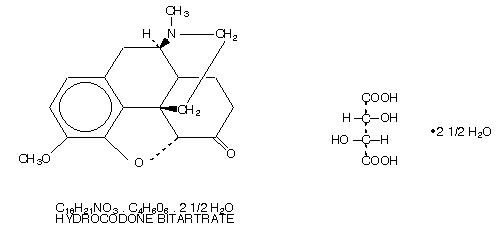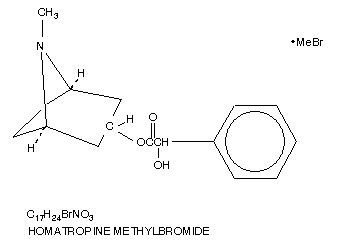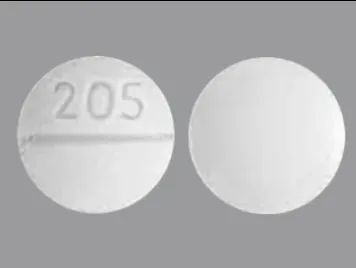Hycodan: Package Insert / Prescribing Info
Package insert / product label
Generic name: hydrocodone bitartrate and homatropine methylbromide
Dosage form: tablets and syrup
Drug class: Upper respiratory combinations
Medically reviewed by Drugs.com. Last updated on Mar 24, 2025.
On This Page
Hycodan Description
HYCODAN contains hydrocodone (dihydrocodeinone) bitartrate, a semisynthetic centrally-acting opioid antitussive. Homatropine methylbromide is included in a subtherapeutic amount to discourage deliberate overdosage.
Each HYCODAN tablet or teaspoonful (5 mL) contains:
Hydrocodone Bitartrate,
USP 5 mg
Homatropine Methylbromide,
USP 1.5 mg
HYCODAN tablets also contain: calcium phosphate dibasic, colloidal silicon dioxide, lactose, magnesium stearate, starch and stearic acid.
HYCODAN syrup also contains: caramel coloring, FD&C Red 40, liquid sugar, methylparaben, propylparaben, sorbitol solution and wild cherry imitation flavor. The hydrocodone component is 4,5α-epoxy-3-methoxy-17-methylmorphinan-6-one tartrate (1:1) hydrate (2:5), a fine white crystal or crystalline powder, which is derived from the opium alkaloid, thebaine, has a molecular weight of (494.50), and may be represented by the following structural formula:


Homatropine methylbromide is 8-Azoniabicyclo [3.2.1]octane,3-[(hydroxyphenyl-acetyl)oxy]-8,8-dimethyl-,bromide, endo-; a white crystal or fine white crystalline powder, with a molecular weight of (370.29).
Hycodan - Clinical Pharmacology
Hydrocodone is a semisynthetic opioid antitussive and analgesic with multiple actions qualitatively similar to those of codeine. The precise mechanism of action of hydrocodone and other opiates is not known; however, hydrocodone is believed to act directly on the cough center. In excessive doses, hydrocodone, like other opium derivatives, will depress respiration. The effects of hydrocodone in therapeutic doses on the cardiovascular system are insignificant. Hydrocodone can produce miosis, euphoria, physical and physiological dependence.
Following a 10 mg oral dose of hydrocodone administered to five adult male subjects, the mean peak concentration was 23.6 ± 5.2 ng/mL. Maximum serum levels were achieved at 1.3 ± 0.3 hours and the half-life was determined to be 3.8 ± 0.3 hours. Hydrocodone exhibits a complex pattern of metabolism including O-demethylation, N-demethylation and 6-keto reduction to the corresponding 6-α- and 6-β-hydroxymetabolites.
Indications and Usage for Hycodan
HYCODAN (hydrocodone bitartrate and homatropine methylbromide) is indicated for the symptomatic relief of cough.
Contraindications
HYCODAN should not be administered to patients who are hypersensitive to hydrocodone or homatropine methylbromide.
Warnings
Hydrocodone can produce drug dependence of the morphine type and, therefore, has the potential for being abused. Psychic dependence, physical dependence and tolerance may develop upon repeated administration of HYCODAN and it should be prescribed and administered with the same degree of caution appropriate to the use of other opioid drugs (see DRUG ABUSE AND DEPENDENCE).
Respiratory Depression
HYCODAN produces dose-related respiratory depression by directly acting on brain stem respiratory centers. If respiratory depression occurs, it may be antagonized by the use of naloxone hydrochloride and other supportive measures when indicated.
Head Injury and Increased Intracranial Pressure
The respiratory depression properties of opioids and their capacity to elevate cerebrospinal fluid pressure may be markedly exaggerated in the presence of head injury, other intracranial lesions or a pre-existing increase in intracranial pressure. Furthermore, opioids produce adverse reactions which may obscure the clinical course of patients with head injuries.
Acute Abdominal Conditions
The administration of HYCODAN or other opioids may obscure the diagnosis or clinical course of patients with acute abdominal conditions.
Pediatric Use
In young pediatric patients, as well as adults, the respiratory center is sensitive to the depressant action of opioid cough suppressants in a dose-dependent manner. Benefit to risk ratio should be carefully considered especially in the pediatric population with respiratory embarrassment (e.g., croup).
Precautions
General
Before prescribing medication to suppress or modify cough, it is important to ascertain that the underlying cause of cough is identified, that modification of cough does not increase the risk of clinical or physiological complications, and that appropriate therapy for the primary disease is provided.
Special Risk Patients
HYCODAN (hydrocodone bitartrate and homatropine methylbromide) should be given with caution to certain patients such as the elderly or debilitated, and those with severe impairment of hepatic or renal functions, hypothyroidism, Addison's disease, prostatic hypertrophy or urethral stricture, asthma, and narrow-angle glaucoma.
Information for Patients
Hydrocodone may impair the mental and/or physical abilities required for the performance of potentially hazardous tasks such as driving a car or operating machinery. The patient using HYCODAN should be cautioned accordingly.
Drug Interactions
Patients receiving opioids, antihistamines, antipsychotics, antianxiety agents or other CNS depressants (including alcohol) concomitantly with HYCODAN may exhibit an additive CNS depression. When combined therapy is contemplated, the dose of one or both agents should be reduced. The use of MAO inhibitors or tricyclic antidepressants with hydrocodone preparations may increase the effect of either the antidepressant or hydrocodone.
Carcinogenesis, Mutagenesis, Impairment of Fertility
Studies of HYCODAN in animals to evaluate the carcinogenic and mutagenic potential and the effect on fertility have not been conducted.
Pregnancy
Teratogenic Effects: Pregnancy Category C
Animal reproduction studies have not been conducted with HYCODAN. It is also not known whether HYCODAN can cause fetal harm when administered to a pregnant woman or can affect reproduction capacity. HYCODAN should be given to a pregnant woman only if clearly needed.
Nonteratogenic Effects
Babies born to mothers who have been taking opioids regularly prior to delivery will be physically dependent. The withdrawal signs include irritability and excessive crying, tremors, hyperactive reflexes, increased respiratory rate, increased stools, sneezing, yawning, vomiting and fever. The intensity of the syndrome does not always correlate with the duration of maternal opioid use or dose.
Labor and Delivery
As with all opioids, administration of HYCODAN to the mother shortly before delivery may result in some degree of respiratory depression in the newborn, especially if higher doses are used.
Nursing Mothers
It is not known whether this drug is excreted in human milk. Because many drugs are excreted in human milk and because of the potential for serious adverse reactions in nursing infants from HYCODAN, a decision should be made whether to discontinue nursing or to discontinue the drug, taking into account the importance of the drug to the mother.
Adverse Reactions/Side Effects
Central Nervous System
Sedation,
drowsiness, mental clouding, lethargy, impairment of mental and physical
performance, anxiety, fear, dysphoria, dizziness, psychic dependence,
mood changes.
Gastrointestinal System
Nausea
and vomiting may occur; they are more frequent in ambulatory than in
recumbent patients. Prolonged administration of HYCODAN may produce
constipation.
Genitourinary System
Ureteral
spasm, spasm of vesicle sphincters and urinary retention have been
reported with opiates.
Respiratory Depression
HYCODAN
may produce dose-related respiratory depression by acting directly on
brain stem respiratory centers (see OVERDOSAGE).
Dermatological
Skin rash,
pruritus.
Related/similar drugs
Drug Abuse and Dependence
HYCODAN (hydrocodone bitartrate and homatropine methylbromide) is a Schedule III opioid. Psychic dependence, physical dependence and tolerance may develop upon repeated administration of opioids; therefore, HYCODAN should be prescribed and administered with caution. However, psychic dependence is unlikely to develop when HYCODAN is used for a short time for the treatment of cough. Physical dependence, the condition in which continued administration of the drug is required to prevent the appearance of a withdrawal syndrome, assumes clinically significant proportions only after several weeks of continued oral opioid use, although some mild degree of physical dependence may develop after a few days of opioid therapy.
Overdosage
Signs and Symptoms
Serious overdosage with hydrocodone is characterized by respiratory depression (a decrease in respiratory rate and/or tidal volume, Cheyne-Stokes respiration, cyanosis), extreme somnolence progressing to stupor or coma, skeletal muscle flaccidity, cold and clammy skin, and sometimes bradycardia and hypotension. In severe overdosage, apnea, circulatory collapse, cardiac arrest and death may occur. The ingestion of very large amounts of HYCODAN may, in addition, result in acute homatropine intoxication.
Treatment
Primary attention should be given to the reestablishment of adequate respiratory exchange through provision of a patent airway and the institution of assisted or controlled ventilation. The opioid antagonist naloxone hydrochloride is a specific antidote for respiratory depression which may result from overdosage or unusual sensitivity to opioids including hydrocodone. Therefore, an appropriate dose of naloxone hydrochloride should be administered, preferably by the intravenous route, simultaneously with efforts at respiratory resuscitation. For further information, see full prescribing information for naloxone hydrochloride. An antagonist should not be administered in the absence of clinically significant respiratory depression. Oxygen, intravenous fluids, vasopressors and other supportive measures should be employed as indicated. Gastric emptying may be useful in removing unabsorbed drug.
Hycodan Dosage and Administration
How is Hycodan supplied
HYCODAN is supplied as a white, biconvex tablet, one face bisected and debossed with “HYCODAN”, and the other face plain, available in:
Bottles of 100 NDC
63481-042-70
Bottles of 500 NDC
63481-042-85
Store tablets at 25°C (77°F); excursions permitted to 15°-30°C (59°-86°F). [See USP Controlled Room Temperature.]
Dispense in a tight, light-resistant container, as defined in the USP, with a child-resistant closure (as required).
HYCODAN is also available as a clear red colored, wild cherry flavored syrup in:
Bottles of one pint NDC 63481-234-16
Store syrup at 25°C (77°F); excursions permitted to 15°-30°C (59°-86°F). [See USP Controlled Room Temperature.]
Oral prescription where permitted by state law.
Manufactured for:
Endo
Pharmaceuticals Inc.
Chadds Ford, Pennsylvania 19317
HYCODAN® is a Registered Trademark of Endo Pharmaceuticals Inc.
Printed in U.S.A.
412042/May, 2003
| HYCODAN
hydrocodone bitartrate and homatropine methylbromide tablet |
||||||||||||||||||||||
|
||||||||||||||||||||||
|
||||||||||||||||||||||
|
||||||||||||||||||||||
|
||||||||||||||||||||||
|
||||||||||||||||||||||
| HYCODAN
hydrocodone bitartrate and homatropine methylbromide syrup |
||||||||||||||||||
|
||||||||||||||||||
|
||||||||||||||||||
|
||||||||||||||||||
|
||||||||||||||||||
| Labeler - Endo Pharmaceuticals Inc. |
More about Hycodan (homatropine / hydrocodone)
- Check interactions
- Compare alternatives
- Pricing & coupons
- Reviews (37)
- Drug images
- Side effects
- Dosage information
- During pregnancy
- Generic availability
- Drug class: upper respiratory combinations
- En español
Patient resources
Professional resources
Other brands
Related treatment guides
Copyright © Endo Pharmaceuticals Inc. 2003

